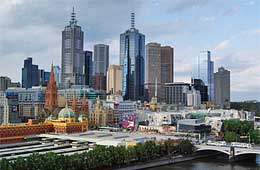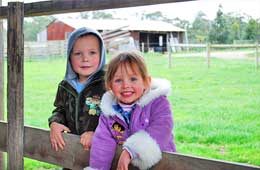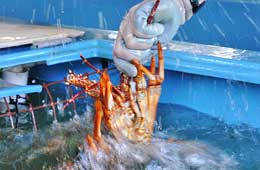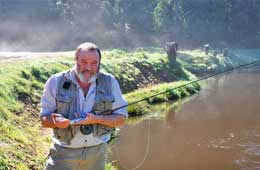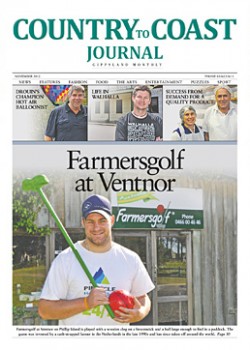WAROOK is a working tourist farm situated on the South Gippsland Highway at Monomeith. The dynamic business is operated by Emma Eidiesdel, a young woman who is committed to showing today’s Australian farming to the rest of the world.
The farm was once part of a pastoral run that was first settled in 1857. The shearing-shed was built in 1887 and the homestead in 1906. Today the homestead and garden caters for various functions and incorporates a gift shop, a café and a restaurant. Horses and dogs are used to work the cattle and sheep, and shearing and wool handling demonstrations take place in the old shearing shed.
Emma’s success comes from having dedicated multi-skilled staff that are capable of undertaking and demonstrating almost everything on the farm. This includes waiting at tables, running tours, working in the kitchen, feeding farm animals and milking cows. It also includes selling gifts in the gift shop, handling sheep and cattle, cracking whips, working with horses and co-ordinating weddings.
Recently she took advantage of a shearing industry initiative to encourage more young people into the shearing and wool handling trade and called on Shearer Woolhandler Training Incorporated, a Victorian government funded subsidiary of The Shearing Contractors Association of Australia. She wanted to equip herself and five of her staff with shearing and wool handling skills. This was so they could show many thousands of international tourists and visiting dignitaries how it is done.
The shearing instructors that have arrived at Warrook are Darren Smith from Naracoorte in South Australia who was once an Australian speed-shearing champion and Pat Lenehan from Koroit in Northern Victoria. “Darren and I came here two years ago,” Pat says. “It was when Emma rang our executive officer wanting some shearer training for herself and a staff member. She has asked us to come back to teach her more and train additional staff so they can shear sheep for tourists without cutting anything they shouldn’t.”
Pat works as a shearing instructor part-time and as a shearing contractor for five months of the year in Western Victoria and part of New South Wales.
Darren has worked as a shearing instructor for six years and works as a shearer for a contractor that organises work for him in South Australia. He says one of the biggest problems facing the shearing industry, is that many older shearers are leaving and not many young people are coming into it. He says the average age of shearers now is about 43 years.
Pat and Darren’s students at Warrook are Emma, five young women she employs and Graeme Bryant from the Mornington Peninsula who has a few sheep of his own. “We don’t normally have many women wanting to shear sheep,” Pat says, “but the girls are keen and they are all going really well.”
Emma has supplied the shed and the lunches, which are surprisingly impressive and served in the stately homestead dining room by her amazing female shearing staff. It is a great opportunity for the students to chat about their newly acquired skills.
Graeme says he has a small farm where he produces a bit of everything and a student minister once showed him how to shear sheep. “Last year my daughter did a shearing course over at Wedderburn and then went on to do wool classing. She started telling me what I should and shouldn’t be doing so I came to Warrook to learn more. I’m a bit old to start shearing commercially but I will shear my own.”
Robyn McLean and Di Wright are the first shearing students to sit down for lunch. Robyn also works at the Victorian Livestock Exchange in Pakenham weighing cattle. “I’ve had a ball and learnt so much,” she says. “Di and I are usually outside running tours and doing dairy demos. We milk in the mornings and afternoons and feed the calves. It’s been good to get over to the shearing shed and learn something new.” “I was dreading it,” Di says. “I was nervous and I couldn’t hold the sheep, but I’m fine now.”
Another student, Amanda Dinger introduces herself. “It rhymes with the ringer,” she says and laughs, “but I am definitely not the ringer. I’m on the chain, so I’m the slowest in the shed.” She says learning to shear sheep is terrifying, but it’s interesting and challenging. “Emma offered the course to anyone that wanted to have a go and we all decided we would. Apart from teaching us how to shear, the instructors are teaching us how to look after the combs and blades, how to sharpen them on the grinder and how to clean the hand piece. They’re also teaching us occupational health and safety.”
Leonie Ryan thinks the shearing and wool handling course is fantastic. “Emma and I did a course here a few years ago, so it’s really coming together for us now,” she says. Shearing student Suzie Bryant says it’s a great experience although it was a bit nerve racking at first.
Emma is a professional engineer and while operating Warrook she is studying law and commerce, and hopes to soon graduate. She is a smart down to earth, energetic woman that continues to walk and talk regardless of the time of day. “I brought in the shearing instructors because we always need to have someone here that can knock the wool off some sheep,” she says. Pat and Darren are great instructors and they are teaching much more than how to give a few blows to the sheep. They have included animal husbandry, how to skirt and sort fleeces, and how to recognise different breeds of sheep.
“Graeme and the girls are doing really well. Graeme doesn’t work at Warrook, he’s a ring in. He can shear but he has been using a flexible down tube, so he is doing the course to learn how to use a solid down tube and it’s different feet positions. The girls are all extremely capable. They all have animal sense and they all come from farms so they have started from a good base, but learning the footholds is still getting to us all. Amanda is incredibly despondent today and Di’s just been throwing her hands up and saying ‘no, I can’t do it’. Even I have difficulty sometimes getting my feet around it.”
“When Chris, our shearer at Warrook shears bellies, he puts the sheep’s leg straight across his stomach,” she says. “We are being taught to put the sheep’s leg behind our leg, which is a blow pattern to alleviate stress. Darren emphasises taking care of the combs and cutters to make the job as easy as possible. He says if he can save a shearer three blows, that could be about 15 sheep a week.”
She says the farm runs off tourism so they purchase sheep in lots of 300 at a time. “Generally, they are first cross or second cross merino so there’s any number of different things in them from Dorset to border Leicester. We shear them, fatten them and then sell them. We grow calves out as F1’s (Friesian cross) with either a Hereford or an Angus terminal sire. We milk dairy cows for 10 months of the year and run replacements. The milk is used to feed the calves and lambs.”
Robyn who likes to give visitors a real farm experience in a warm, easy-going, friendly manner says she is an ambassador for her country. Amanda agrees and says: “Anyone can serve a meal and show someone something, but at Warrook we all like to package it in a special way.”
By Wendy Morriss
Copyright © 2012 Wendy Morriss: Freelance Journalist. All Rights Reserved.
